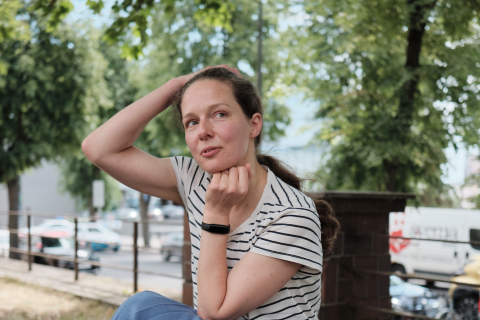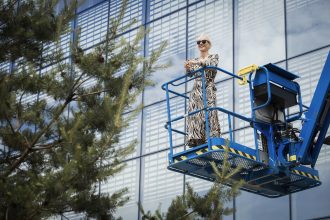Veronika Šleivytė (1906–1998) is usually presented as an artist who continued and enriched the traditions of her teachers at the Kaunas Art School. Photography is only a fourth profession stated in her biography, however, in recent years it is precisely this extremely rich collection that is of interest to more and more researchers and thinkers.
Last July, director Eglė Švedkauskaitė took Eglė Gabrėnaitė, Elžbieta Latėnaitė, Justina Mykolaitytė and the entire creative group to Kupiškis, where Vėra – as the artist is more often called today – comes from. In that camp a performance was born, which was premiered at Sirenos festival.

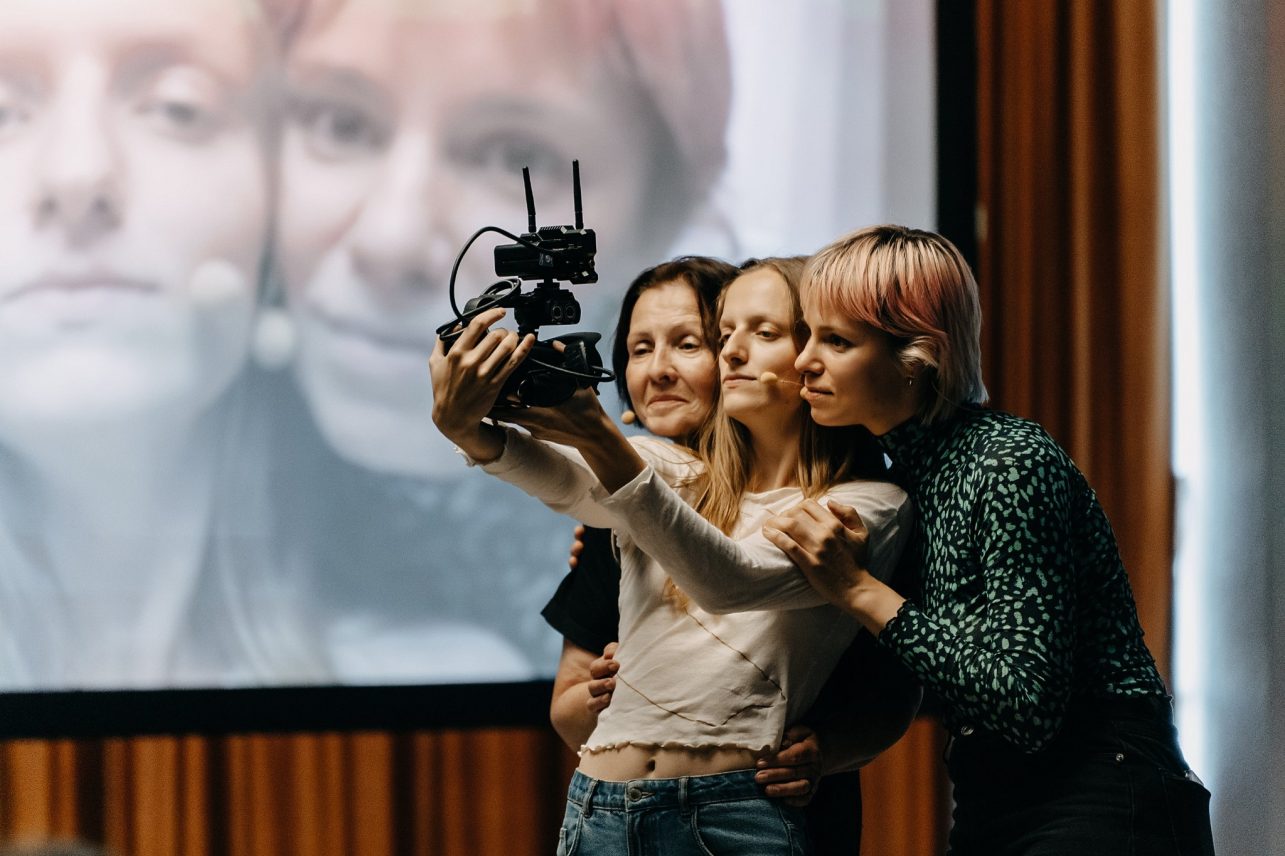

From the capital’s bubble open (sic) to artistic experimentation, the performance Looking at Each Other returned to the periphery. At the invitation of the international performing arts festival ConTempo it was shown in the towns of the Kaunas district in August. After visiting Domeikava (by the way, for the first time – thanks to the festival), I immersed myself in a meeting of kindred spirits I have never met before. Often, contemporary art tempts you to get involved, but you are afraid of your lack of understanding, but the group photo at the end of the performance came out really well, as if it wasn’t directed at all, although it was and very carefully. E. Latėnaitė directed it, just as Vėra loved doing it. After such a shamelessly long introduction, all we had to do with Eglė Švedkauskaitė, is to sit down one hot morning and see how things turned out.
The premiere of the performance took place in the capital’s SODAS2123 space, whose visitors represent a circle that knows the context of contemporary art well. ConTempo festival took the piece to the Kaunas district – Domeikava, Ramučiai, Kulautuva – which still has a lack of similar events. These are very different areas. What do you think of this contrast, did it work?
This tour was offered by ConTempo. I think it is brave and that is why I found it interesting and exciting. I didn’t know what to expect, but yes, I came out of the artist bubble. It was a sort of checkup. Both in Vilnius as well as here, we received nice reviews and positive comments. The reactions are not always expected but that’s okay. In general, the reactions are very positive, which is even strange. I did not receive much criticism even from colleagues, with whom I can talk more openly. This is unusual for me, I don’t tend to consider my work as perfect, it seems to me to be flawed. Something worked, something didn’t.
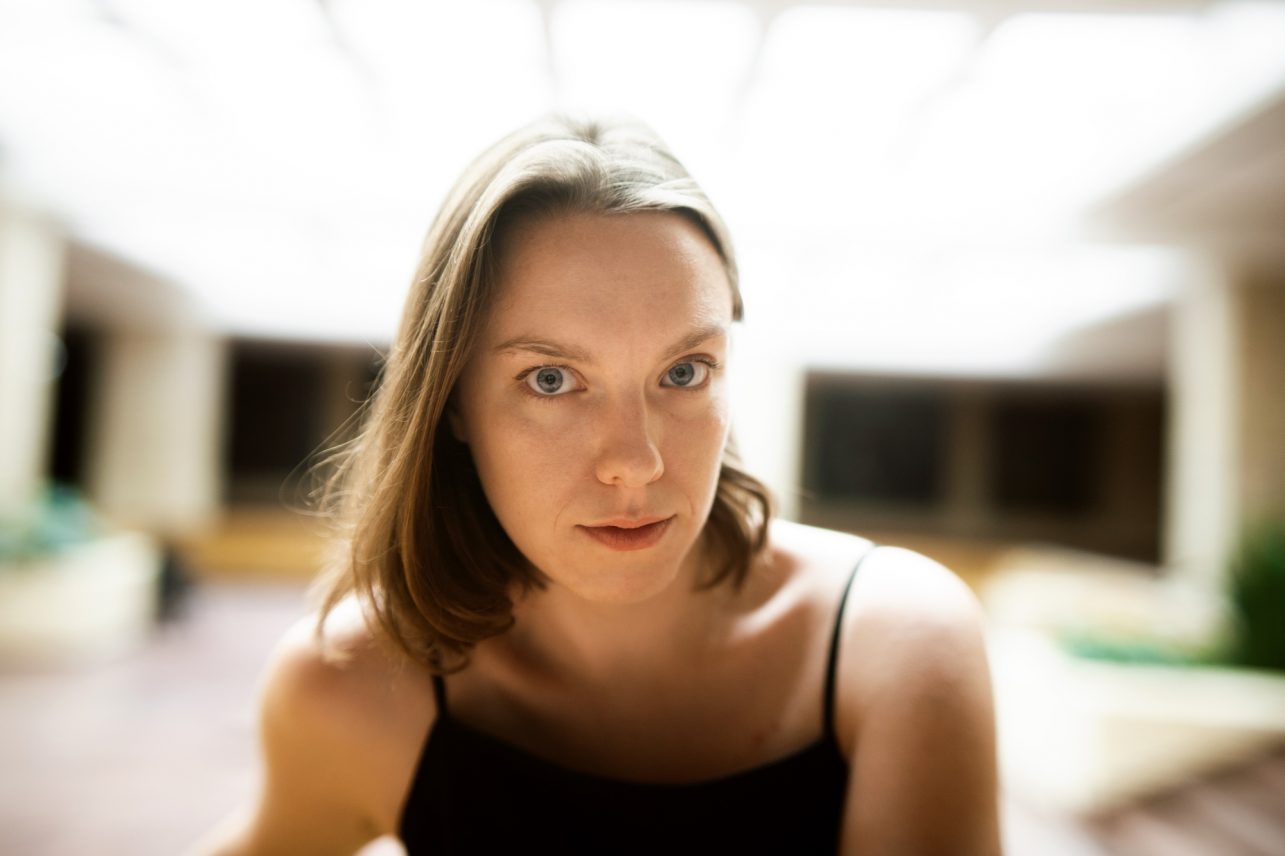
Our conversation is taking place before the third stop of the tour in Kulautuva. I have seen a performance in Domeikava, and it was a really cozy evening. How did it go in Ramučiai?
Audiences are different. In Domeikava, as you said, the audience was warm, cozy, supportive and sensitive. Ramučiai is much more restrained. Maybe I am interpreting it wrong, but I think they expected a play with Eglė Gabrėnaitė. Her last name means a lot, I accept it as a normal fact. If that’s what draws them in: good. If they’re disappointed not to see her as the lead actress, that’s just an issue with their expectations.
After all, we do not advertise the work as a benefit for Gabrėnaitė. So Ramučiai might have expected a clearer form, there was more tension and less participation. The performance is not interactive, but it does not draw strict boundaries between the viewer and the performer, everything is here and now, there is no stage, the performers are not separated from the audience. In Domeikava, people were more empathetic both in their reactions and in real participation when Elžbieta directed the photo.
Which of the three participants was the most difficult to persuade to create Looking at Each Other?
It wasn’t difficult. Maybe it was just harder for me to get ready and breathe out all the anxiety on the day I had to call Eglė. Until then, I had only encountered her when I worked as an assistant to the director of the play. I thought that there are two actresses in Lithuania who could participate in this performance, although it was not yet clear what will happen. I just wanted three performers of different ages and experiences.
There was some nervousness. At first, she said, “I am leaving theatre, I don’t want to act anymore.” But then we started talking about Šleivytė. She said that she had met Šleivytė face to face in Kaunas Musical Theater when she was a teenager, and Veronika was already an elderly Kaunas resident. That helped to continue the conversation, we met, and everything went well. Justina and I had worked on another project, and I knew Elžbieta from assistant jobs, we were friends both professionally and personally, so it wasn’t difficult either.
You said that Eglė Gabrėnaitė has decided to leave theater, stop acting. But! It seemed to me, perhaps naively, that she does not act at all in this performance.
Yes, yes, yes, not naively, this is the essence of the performance itself. There are no roles here, just extensions of real personalities into certain themes. But on the stage, you will find the women, whose names are listed on the program with their names, surnames and stories. Eglė tells real stories about being on the set of Journey to Paradise film, about the demands of director Arūnas Žebriūnas, Elžbieta reads a real letter to her mother, Justina sings lines from her poems, which she wrote specifically for this performance. We wanted them to be themselves.
How did your personal relationship with Vėra Šleivyte develop? It seems that interest in this artist has been rekindled once again. Sometimes Vėra Looks Like That exhibition will be running at the National Gallery of Art until October and I have an urge to visit it even more after seeing the performance.
I like that it has been rekindled, I found myself at the right time. In Autumn of 2020, with the second quarantine approaching, it was sad and clear that a long period of time at home was ahead of us. I started to think that I should write an application to the Lithuanian Council for Culture. I wondered what it should be about. Accidentally, I saw a sponsored post on Facebook. It was an article with a headline like, “The identity of the Lithuanian photographer who loved women was revealed” or something like that. There was one photo there of her and one of her lovers, Laura. The photo stuck with me because in it Šleivytė is gently pressing over her shoulder… I thought, wow, I have never seen such Lithuanian photos, I need to press on that link. I read the article and found more attached photos. Cool, I thought to myself, she worked at the time when Lithuania was developing, and she is one of those hidden women. Well, if we were to follow the narrative that Lithuania was created by those 20 men from a well-known photograph. And from school I still remember Žemaitė, Felicija Bortkevičienė, Lazdynų pelėda and Šatrijos ragana – that’s about it. But they existed! Women were always there. At the same time, I began to think that the history I was studying was not the real history. It was only one of many possible narratives.

I am generally interested in the themes of memory and the past, our identity. So, I thought, maybe I should tell a story about the women who created Lithuania. The more I looked into it, the more I realized that it has less to do with the state and history, and more to do with the individual creation and being a member of the LGBTQ+, as we now call it. I don’t know about others, but no one told us about it in my school. I find it very interesting! As far as I understood, Vėra was quite open, thus very brave. I was drawn to that boldness. Everything led to a picture of a woman I had never seen in Lithuania. I found a wonderfully designed delicate, and aesthetic album Foto Vėros Šleivytės, which was compiled by Milda Dainovskytė and Agnė Narušytė (they also curated the exhibition at the National Gallery of Art, ed. Note). By the way, we also use the album in the performance.
I realized that I don’t want to create a biographical play about Vėra, but rather draw inspiration from her. This is how the idea came to look for a way to talk about the female gaze, as an alternative to the male gaze. (In feminist theory, the male gaze, is defined as a depiction of a woman in artworks from the perspective of a heterosexual man “behind the camera”. In this way, two more male perspectives are created: male characters in the work and viewers, regardless of their gender, and then the male gaze becomes all-encompassing). This topic concerns me too, because I work in theater that is a stronghold of male directors, only now things are starting to change. I have worked a lot as an assistant, I have seen how a man directs a woman and what stereotypes are prevalent there. Or, when I work as a director myself, someone from the side comments: oh, how difficult it is, only a man could do it. All these themes wrapped around Šleivytė and she became one of the sources of the performance.
Would you call it a creative monument, perhaps an homage to her? As an alternative to a traditional monument.
You reminded me of something. When you go to Šleivytė’s birthplace in Antašava outside Kupiškis, at the turn to the homestead, there is a wooden sculpture of a Lithuanian girl. She ordered this monument for herself and erected it.
She was ahead of her time.
Yes, definitely [laughs]. The museum wants to replace that sculpture with a camera and a bird. I don’t know what is better. But back to your question: yes, it is a tribute to her.
Let’s talk about those male strongholds. One thing that has puzzled me for a long time is when the best actors and actresses are chosen at award ceremonies, but directors and other professions are not divided in this way. What do you think about it? How would you feel if you got the Golden Cross of the Stage in 2021 as the best female director?
I remember how one year at the Golden Crosses, no woman got an award because, according to the commission, there were no competitive roles. It was also strange. And why is that? I think it’s because awards are a very old thing. There were simply no or very few female directors or composers. Also, women and men go to separate castings, they really create different roles. It would be interesting to hold a joint casting for the same role.
I’m glad that when I was nominated in the Young Artist category with two guys, both genders were mentioned. If I won Best Female Director, I’d probably feel weird. I am greatly affected by external opinion; I think about it. Not much might remain but, of course, it always resonates with me. So, I wonder how the public would react; would a male director be the real one and the female would get a consolation cross?
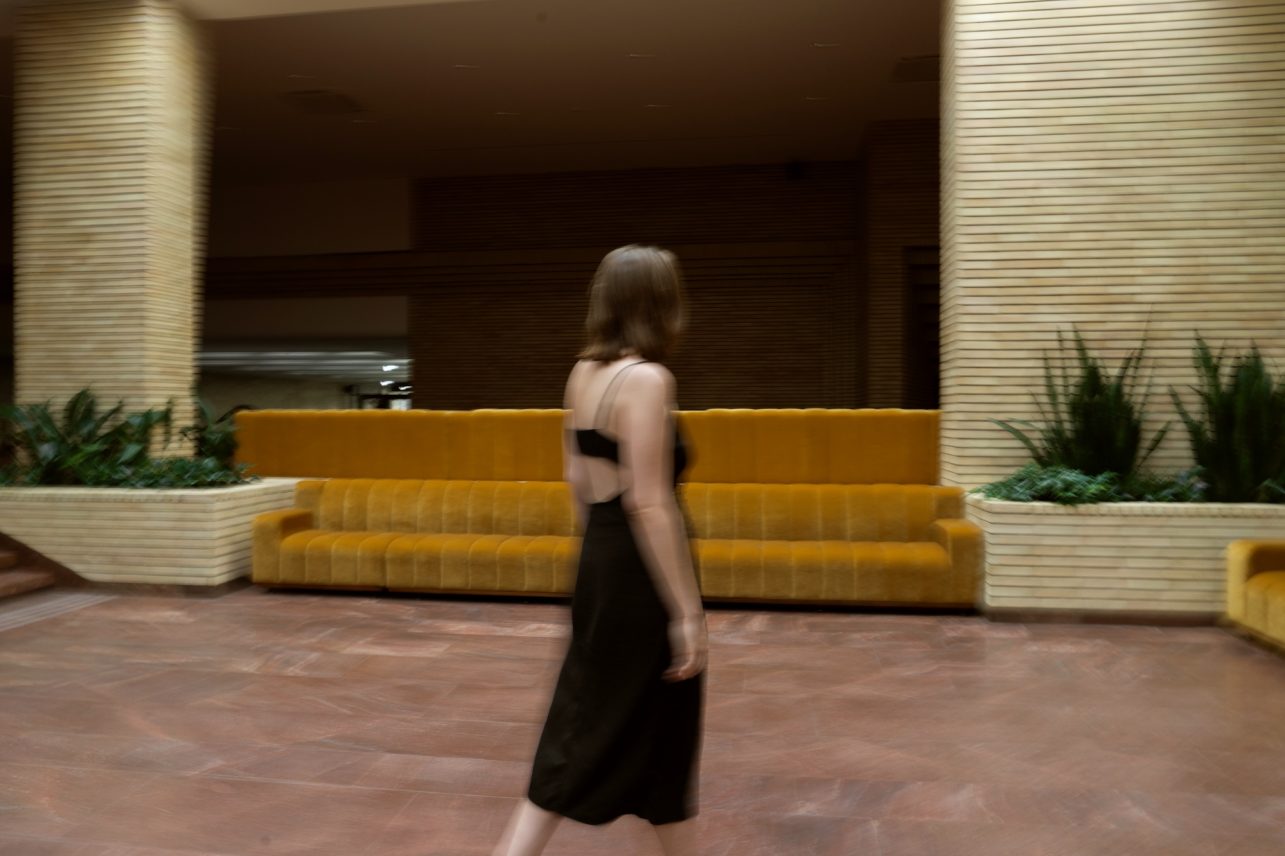
Work in traditional theater and performance: how much do they complement each other for you and why do you want to not limit yourself to one genre?
Looking at Each Other and the process of creating a performance inspired an even greater desire in me to get out of the box, out of the traditional confrontation with the viewer. I want to experiment with how the audience and the actors affect each other. Maybe because I don’t always understand, but sometimes I get that it is not through understanding that one should travel to contemporary, visual art. I have ambitions to touch upon it. For me it is a bigger mystery than the theater stage, where I already know at least the basic rules. I received a rather traditional education at the Lithuanian Academy of Music and Theater. The more productions I see, or the more I travel and get to know other creators, the more I want a different point of view. I think it provides freedom. You free yourself and start being less judgmental to others. Like saying, this is not theatre, it’s an installation, what does theatre have to do with it? This attitude surrounded me it he academia, the professors used to say that. For example, Heroes’ Square is one of the strongest experiences in my early academic phase. There were teachers who said that this is a complete scam, not acting. I read how Krystian Lupa talked about his creative strategy, and I felt it.
What are you working on now?
The rudiments of the dramaturgy of a new play are developing, the scenario is being put together. The play will be shown next spring at the Lithuanian National Drama Theater in Vilnius. Its subject is complex: Siberian exiles. I would like to touch on this perspective: exile as a transgenerational trauma reaching the third – my – generation. Maybe that’s how I’ll close the memory topic. I only recently realized that my recent works are all about this, about the signs of memory today. Or maybe the topic will expand and turn elsewhere.


